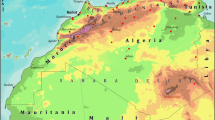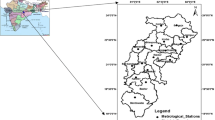Abstract
This paper presents an examination of precipitation amounts in Pakistan. For this purpose, the annual precipitation and the annual number of precipitation days have been calculated, and a study aimed at investigating precipitation intensity and decadal changes was conducted. Precipitation trends have been calculated using a simple linear regression method and Kendall’s tau-based test. To assess stability and differences, a 10-year span was determined for each precipitation region for the period of 1951–2010. This study focused on the three CLINO (Climatological Normal) periods, namely 1961–1990, 1971–2000, and 1981–2010 (the latest global standard normal period). Results confirm the gradual increase of annual precipitation in southwestern coastal areas of Pakistan and Cholistan desert. With regard to annual number of precipitation days, in the central part of the country negative trends were evident for wet days (with precipitation ≧ 0.1 mm), while the number of rainy days (with precipitation ≧ 1 mm) displayed a prominent positive trend. The series of the precipitation intensity gives evidence of a minor decrease in the Baluchistan Plateau, sub-Himalayas, and Potwar Plateau during the study period. Examination of secular trends evidenced that the Murree hills, the upper Indus plain, and the northwestern Baluchistan plateau have had shifts in their precipitation regime towards drier conditions, while the central plain, the northwestern mountains, and the southern part of the country are shifting in their precipitation regime towards wetter conditions. Description among the means of precipitation amounts suggests that “normal” precipitation data for various national projects should be calculated for the last 30 years.
Similar content being viewed by others
References
Afzal, M., and Q. Zaman, 2010: Case study: Heavy rainfall events over Lai Nullah catchment area. Pak. J. Meteor., 6, 39–48.
Almazroui, M., M. N. Islam, H. Ather, P. D. Jones, and M. A. Rahman, 2012: Recent climate change in the Arabian Peninsula: annual rainfall and temperature analysis of Saudi Arabia for 1978–2009. Int. J. Climatol., 32, 953–966.
Arguez, A., and R. S. Vose, 2011: The definition of the standard WMO climate normal: The key to deriving alternative climate normal. Bull. Amer. Meteor. Soc., 92, 699, doi: 10.1175/2010BAMS2955.1.
Baig, M. H. A., and G. Rasul, 2009: The effect of Eurasian snow cover on the monsoon rainfall of Pakistan. Pak. J. Meteor., 5, 1–11.
Brunetti, M., L. Buffoni, M. Maugeri, and T. Nanni, 2000: Precipitation intensity trends in northern Italy. Int. J. Climatol., 20, 1017–1031.
____, M. Maugeri, and T. Nanni, 2001: Changes in total precipitation, rainy days and extreme events in northeastern Italy. Int. J. Climatol., 21, 861–871.
Buishand, T. A., G. De Martino, J. N. Spreeuw, and T. Brandsma, 2013: Homogeneity of precipitation series in the Netherlands and their trends in the past century. Int. J. Climatol., 33, 815–833.
Cruz, R. V., H. Harasawa, M. Lal, S. Wu, Y. Anokhin, B. Punsalmaa, Y. Honda, M. Jafari, C. Li, and N. Huu Ninh, 2007: Asia. Climate Change 2007: Impacts, Adaptation and Vulnerability. Contribution of Working Group II to the Fourth Assessment Report of the Intergovernmental Panel on Climate Change, M. L. Parry, O. F. Canziani, J. P. Palutikof, P. J. van der Linden and C. E. Hanson, Eds., Cambridge University Press, Cambridge, UK, 469–506.
Efstathiou, M. N., and C. A. Varotsos, 2012: Intrinsic properties of Sahel precipitation anomalies and rainfall. Theor. Appl. Climatol., 109, 627–633.
Farooqi, A. B., A.H. Khan, and H. Mir, 2005: Climate change perspective in Pakistan. Pak. J. Meteor., 2, 11–21.
Gadiwala, M. S., 2006: Climate of Karachi. Geographical papers, 1, 51–59.
Guhathakurta, P. and M. Rajeevan, 2008: Trends in the rainfall pattern over India. Int. J. Climatol., 28, 1453–1469
Hänsel, S., S. Petzold, and J. Matschullat, 2007: Precipitation trend analysis for Central Eastern Germany, in Střelcová, K., Škvarenina, J. and Blaženec, M. (eds.). Bioclimatology and Natural Hazards, Springer.
Hassan, M. A., S. Haider, and U. Kalim, 2010: Diagnostic study of heavy downpour in the central part of Pakistan. Pak. J. Meteor., 7, 53–61.
Hussain, M. S., and S. Lee, 2008: Gladiolus production a successful example in the climate of Khanaspur, Ayobia district Hazara, NWF (Province) Pakistan. The Geographical Journal of Korea, 42, 177–181.
____, and _____, 2009: A classification of rainfall regions in Pakistan. J. Korean Geogr. Soc., 44, 605–623.
____, and _____, 2013: The regional and the seasonal variability of extreme precipitation trends in Pakistan. Asia-Pac. J. Atmos. Sci., 49, 421–441.
Htway, O., and J. Matsumoto, 2011: Climatological onset dates of summer monsoon over Myanmar. Int. J. Climatol., 31, 382–393.
Kazi, S. A., 1951: Climatic regions of West Pakistan. Pak. Geogr. Rev., 6, 1–22.
Khan, A. H., 2004, The influence of La-Nina phenomena on Pakistan’s precipitation. Pak. J. Meteor., 1, 23–31.
Kim, Y., B. Kang, and J. M. Adams, 2012: Opposite trends in summer precipitation in South and North Korea. Int. J. Climatol., 32, 2311–2319.
Kulkarni, M. A., A. Singh, and U. C. Mohanty, 2012: Effect of spatial correlation on regional trends in rain events over India. Theor. Appl. Climatol., 109, 497–505.
Lau, K. M., and H. T. Wu, 2007: Detecting trends in tropical rainfall characteristics, 1979–2003. Int. J. Climatol., 27, 979–988.
Liebmann, B., C. S. Vera, L. M. V. Carvalho, I. A. Camilloni, M. P. Hoerling, D. Allured, V. R. Barros, J. Báez, and M. Bidegain, 2004: An observed trend in Central South American precipitation. J. Climate, 17, 4357–4367.
Lupikasza, E., 2010: Spatial and temporal variability of extreme precipitation in Poland in the period 1951–2006. Int. J. Climatol., 30, 991–1007.
Naheed, G. and G. Rasul, 2011: Investigation of rainfall variability for Pakistan. Pak. J. Meteor., 7, 25–32.
Pnevmatikos, J. D., and B. D. Katsoulis, 2006: The changing rainfall regime in Greece and its impact on climatological means. Meteor. Appl., 13, 331–345.
Rasul, G., Q. Z. Chaudhry, and A. Mahmood, 2011: Numerical Simulation of Heavy rainfall case of South Asia. Pak. J. Meteor., 6, 21–36.
Rashid. A., 2004: Impact of El-Nino on Summer Monsoon rainfall of Pakistan. Pak. J. Meteor., 1, 35–43.
Rashid, K., and G. Rasul, 2009: Rainfall variability and maize production over the Potohar Plateau of Pakistan. Pak. J. Meteor., 8, 63–74.
Rehman, S., 2009: Temperature and rainfall variation over Dhahran, Saudi Arabia, (1970–2006). Int. J. Climatol., 30, 445–449.
Sabin, T. E., and M. D. Shulman, 1985: A statistical evaluation of the efficiency of the climatic normal as predictor. J. Climatol., 5, 63–77.
Sajjad, S. H., B. Hussain, M. A. Khan, A. Raza, B. Zaman, and I. Ahmad, 2009a: On rising temperature trends of Karachi in Pakistan. Climatic Change, 96, 539–547.
____, S. A. Shirazi, M. A. Khan, and A. Raza, 2009b: Urbanization effects on temperature trends of Lahore during 1950–2007. Int. J. Clim. Change Strategies and Management, 1, 274–281.
Shahid, S., 2009: Rainfall variability and the trends of wet and dry periods in Bangladesh. Int. J. Climatol., 30, 2299–2313.
Shirazi, S. A., F. Zahid, and M. H. Bokhari, 2004: Rainfall variability and its impact on some selected crops of Punjab-Pakistan 1973-2003. J. South Asian Stud., 22, 107–133.
Sivakumar, M. V. K., H. P. Das, and O. Brunini, 2005: Impacts of present and future climate variability and change on agriculture and forestry in the arid and semi-arid Tropics. Climatic Change, 70, 31–72.
Sultana, H., N. Ali, M. M. Iqbal, and A. M. Khan, 2009: Vulnerability and adaptability of wheat production in different climatic zones of Pakistan under climate change scenario, Climatic Change, 94, 123–142.
Syed, F. S., F. Giorgi, J. S. Pal, and M. P. King, 2006: Effect of remote forcing on the winter precipitation of central southwest Asia part1: observations. Theor. Appl. Climatol., 86, 147–160.
Tarhule, A., and M. K. Woo, 1998: Changes in rainfall characteristics in northern Nigeria. Int. J. Climatol., 18, 1261–1271.
Uganai, L. S., 1992: Changes in Zimbabwe’s rainfall regime and the effect on climatological means (normal). Proceeding, 5 th International meeting on Statistical Climatology, Toronto, Canada, 127–131.
Villarini, G., 2011: Analyses of annual and seasonal maximum daily rainfall accumulations for Ukraine, Moldova, and Romania. Int. J. Climatol., 32, 2213–2226.
Wang, B., and F. Zhen 1999: Choice of south Asian summer monsoon indices. Bull. Amer. Meteor. Soc., 80, 629–638.
____, and Q. Ding, 2006: Changes in global monsoon precipitation over the past 56 years. Geophys. Res. Lett., 33, L06711, doi:10.1029/2005GL025347.
____, and Q. Ding, 2008: Global monsoon: Dominant mode of annual variation in the tropics. Dyn. Atmos. Oceans, 44, 165–183.
WMO, 2007: The role of climatological normal in changing climate, World Meteorological Organization, WCDMP, 61, 1–46.
Zhai, P., X. Zhang, H. Wan, and X. Pan, 2005: Trends in total precipitation and frequency of daily precipitation extremes over China. J. Climate, 18, 1096–1108.
Zhou, T., R. Yu, H. Li, and B. Wang, 2008a: Ocean forcing to changes in global monsoon precipitation over the recent half-century. J. Climate, 21, 3833–3852.
____, L. Zhang, and H. Li, 2008b: Changes in global land monsoon area and total rainfall accumulation over the last half century. Geophys. Res. Lett., 35, L16707, doi:10.1029/2008GL034881.
____, D. Gong, J. Li, and B. Li, 2009: Detecting and understanding the multi-decadal variability of the East Asian Summer Monsoon — Recent progress and state of affairs. Meteor. Z., 18, 455–467.
____, S. Brönnimann, T. Griesser, A. M. Fischer, and L. Zou, 2010: A reconstructed dynamic Indian monsoon index extended back to 1880. Clim. Dynam., 34, 573–585.
Zhang, L., and T. Zhou, 2011: An assessment of monsoon precipitation changes during 1901–2001. Clim. Dynam., 37, 279–296.
Author information
Authors and Affiliations
Corresponding author
Rights and permissions
About this article
Cite this article
Hussain, M.S., Lee, S. Long-term variability and changes of the precipitation regime in Pakistan. Asia-Pacific J Atmos Sci 50, 271–282 (2014). https://doi.org/10.1007/s13143-014-0015-8
Received:
Accepted:
Published:
Issue Date:
DOI: https://doi.org/10.1007/s13143-014-0015-8




